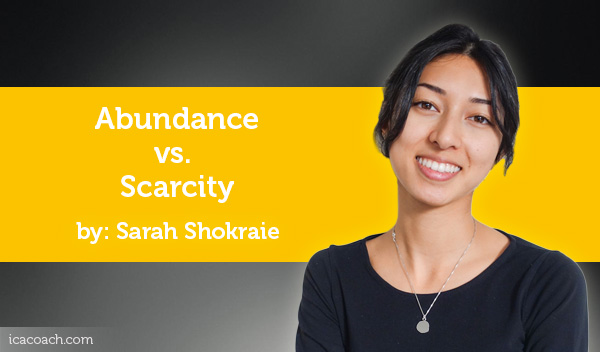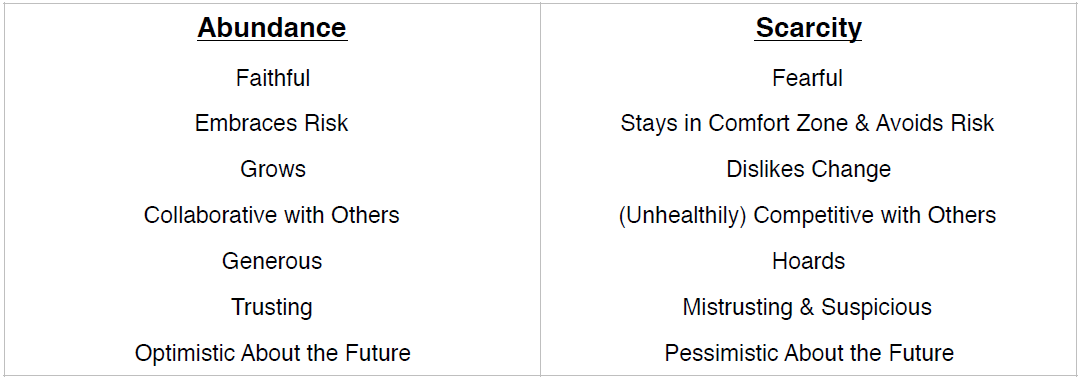
A Coaching Power Tool Created by Sarah Shokraie
(Personal Growth Coach, CANADA)
Be thankful for what you have; you’ll end up having more. If you concentrate on what you don’t have, you’ll never, ever have enough. —Oprah Winfrey
One of the most powerful mindset shifts one can make is from scarcity to abundance. Oxford Dictionary defines abundance as “the state or condition of having a copious quantity of something; plentifulness.” When we live in abundance, we allow life’s opportunities to flow to us. It is based on the understanding that there is enough for ourselves and for everyone, whether that be resources, success or even emotions. In The 7 Habits of Highly Effective People, Steven Covey writes that an abundance mindset, “flows out of a deep inner sense of personal worth or security.” An abundance mindset stems from knowing our true value as an individual and not letting fears and emotions overtake us. Living in abundance does not necessarily mean wealth or having many possessions, but it is from being grateful for what we do have. It is seeing a silver-inning in every situation and believing that even unfavourable outcomes hold lessons to learn from and can account to one’s personal growth and development.
A scarcity mindset, on the other hand, is based on fear and the ego. Living in scarcity is incredibly common, as most people unknowingly begin developing this mentality from a young age. Through school, sports, media and the workplace, we are taught to compare ourselves to others and compete to be the best. Healthy competition can be beneficial, especially if it encourages us to grow and become better versions of ourselves, but competition can also lead to feelings of being less than enough when overdone. The roots of scarcity lie in the idea of “survival of the fittest”, where we must compete for resources to live.
The Law of Attraction
The Law of Attraction simply states that “like attracts like.” Our reality is a product of our thoughts, therefore, when we change the way we think, so do our circumstances. When we have a mindset of scarcity, we attract scarcity into our lives. When we live in abundance, we attract abundance into our lives.

Case Study
A client came to our session battling between the decision to keep his day job as an electrician or to leave it to pursue his passion for music. His day job gave him financial security but left him feeling emotionally and physically drained, unhappy and gave him little time to work on musical projects on the side. When asked, the risk of pursuing music full time would mean uncertainty in his finances for an unknown period of time. The reward would be achieving a lifelong dream of becoming a musician full time and doing what he loved and did best. However, due to his fear of not being able to make enough money, the client felt anxious and trapped with what to do.
What We Discussed:
The client’s scarcity perspective was that he would not make it as a musician and would not be able to pay his bills because of it. His fear of not having enough blocked him from seeing his potential and the possibility of things going right. He was left feeling that the decision between the two careers was “all or nothing”, and was unable to see other options. His shift to a perspective of abundance left him feeling hopeful and less fearful of the uncertainty his future would hold. It also reminded him to recognize the income he was making as proof that he was able to do it, therefore it was not an unrealistic dream.
Coaching Application
Creating a safe and trusting space for the client to feel comfortable with sharing and being open is key to every coaching relationship. For client’s who feel their situation is a “doomsday”, we can challenge their perspective in a non-judgemental way to one where there is more than one option, because in most cases, there is. Explore the risk versus the reward with the client.
To shift a client’s perspective from one of scarcity to one of abundance, a coach can invite the client to think about a time when they were at their best or felt they “had it all.” Exploring what their attitude was like during that time will allow them to compare themselves to their current attitude. If a client isn’t already doing so, implementing a gratitude journal or inviting the client to think of what they are thankful for in their situation is powerful. Encourage the client to seek out the options and opportunities when challenges arise.
Questions to Shift from Scarcity to Abundance:
What is good thing that can come from this?
What judgement are you making that might be leading you to feel like there is not
enough?